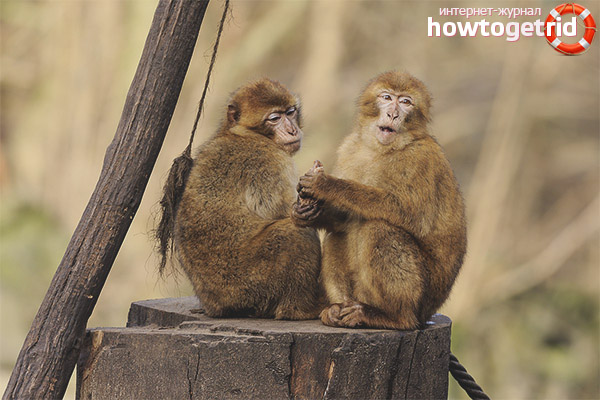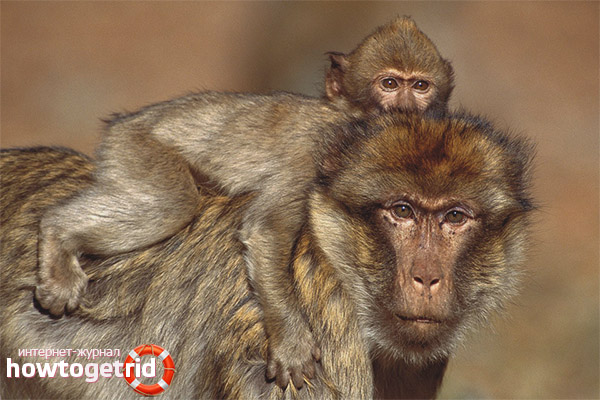The content of the article
Magot is a species of monkey and belongs to the genus of macaques. Being the only species of macaques living outside of Asia, it is distributed in the Atlas, as well as the Moroccan, Libyan, Algerian states. On the territory is considered the only species species of primates.
Description
Females are generally smaller in size than males — approximately 56 cm long and weighing no more than 10 kg. Males are found with a body length of about 72 cm and a weight within 15 kg. The face has a dark pinkish tint, and the front legs are longer than the hind legs.
The tail length does not exceed 2 cm, it is practically invisible, it is rudimentary. The hair of individuals usually has a diverse color - from grayish to brownish-yellow. Sometimes there are reddish shades.
Nutrition
Habitat
Representatives of this species live in the Atlas, in the Moroccan, Algerian states. In the mountains, individuals are distributed at an altitude of 2300 m above sea level and are able to withstand low temperatures up to -10 ° C. A comfortable habitat for magoths is considered forests, consisting for the most part of pines, cedars or oaks. Such forest zones are full of pasture - roots, sprouts, seeds, buds and insects.
Gender differences
The differences between males and females of this subspecies are represented by the difference in size. The males are larger than females.
Behavior features
Inhabited on a lowland in mountainous terrain, this subspecies of primates usually chooses cedar woods, light spruce thickets, meadows for living. Magots are considered sociable and create groups of 10-100 monkeys of different sexes. At the same time, each herd can inhabit several square kilometers, even in conjunction with other herds of brothers.
Among males, hierarchical relationships are traced. In case of a possible aggressive reaction, the male takes the baby with him, and then both males begin to take care of the cub, checking its fur for insects. Thus, a decrease in aggression occurs due to distraction. But still, the main ones in such herds are female. It is they themselves who choose a mate, looking not so much at the stronger, but at the more caring of the kids and brothers of the male.
Fact! Even having their own cubs, males are often busy raising other babies, caring for them and protecting them from dangerous animals. They like to take care of children and spend a lot of time with them during the day.
At night, they sleep on tree branches or climb rocks. In the afternoon, they slowly and decently bypass their territories, seeking food. And although they mostly walk on all fours in order to explore their surroundings, they rise on two legs.
Breeding
During the breeding season, the females themselves choose a male, which in the future will help them take care of the baby. Thus, this helps to strengthen relations between dads and children, and with other male representatives in the already formed group. Females choose several males as a pair at once.
As a rule, the mating season begins in November and ends in March. Pregnancy lasts 6 months, and usually one baby is born. Another year, my mother feeds the baby with milk.
Adult males begin to take care of the cub a few days after its appearance. At the same time, they take the baby in their arms, shelter from the wind, brush their fur and play. To mothers they give crumbs only for feeding milk. Males show their babies to other males and allow each other to take them for a while for games and education.
Cubs differ from adults in color - their fur has a black tint, and their faces are light in color. Puberty in young animals occurs at the age of 3-4 years, the wool at this time already acquires shades characteristic of adults. Primates live on average up to 22 years, although females can live a little longer, surviving males for several years.
Endangered species and interesting facts
Despite the large population of the species, there are some small territories where magotas are almost endangered (about 200 individuals in total). In the last century, only a few dozen individuals remained, and various measures were taken to preserve the species. Due to this, the number again increased to normal. The negative impact on the life of these primates is provided by hunting, deforestation and the eradication of the natural habitat. Also, local residents destroy these animals, equating them with pests. In northern Africa, there are now about 15 thousand individuals.
Interestingly, the magicians were also depicted on coins. On 5 pence of Gibraltar, monkeys were depicted, and on the other hand, a portrait of the Queen of England was depicted.
There is a legend that as long as magicians live in the mountains, Gibraltar will be considered English. Therefore, since the 19th century, they have been under the auspices of the British Navy. The British about this legend say they will defend these primates until the last Briton. In the middle of the last century during the war, the number of these monkeys was in the amount of only a few individuals, and then the Prime Minister of Great Britain ordered the importation of forest primates from all their habitats.
It is also believed that due to the fact that there is a place where the Gibraltar Current has a narrow gap between the shores, there is an underpass. It is this passage that allows individuals to move under the strait, living in Morocco and on the rocks.
Video: macaque magot











Submit